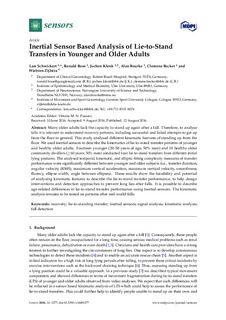Inertial sensor based analysis of lie-to-stand transfers in younger and older adults
| dc.contributor.author | Schwickert, Lars | |
| dc.contributor.author | Boos, Ronald | |
| dc.contributor.author | Klenk, Jochen | |
| dc.contributor.author | Bourke, Alan | |
| dc.contributor.author | Becker, Clemens | |
| dc.contributor.author | Zijlstra, Wiebren | |
| dc.date.accessioned | 2020-02-24T09:51:58Z | |
| dc.date.available | 2020-02-24T09:51:58Z | |
| dc.date.created | 2017-02-28T21:44:45Z | |
| dc.date.issued | 2016 | |
| dc.identifier.issn | 1424-8220 | |
| dc.identifier.uri | http://hdl.handle.net/11250/2643375 | |
| dc.description.abstract | Many older adults lack the capacity to stand up again after a fall. Therefore, to analyse falls it is relevant to understand recovery patterns, including successful and failed attempts to get up from the floor in general. This study analysed different kinematic features of standing up from the floor. We used inertial sensors to describe the kinematics of lie-to-stand transfer patterns of younger and healthy older adults. Fourteen younger (20–50 years of age, 50% men) and 10 healthy older community dwellers (≥60 years; 50% men) conducted four lie-to-stand transfers from different initial lying postures. The analysed temporal, kinematic, and elliptic fitting complexity measures of transfer performance were significantly different between younger and older subjects (i.e., transfer duration, angular velocity (RMS), maximum vertical acceleration, maximum vertical velocity, smoothness, fluency, ellipse width, angle between ellipses). These results show the feasibility and potential of analysing kinematic features to describe the lie-to-stand transfer performance, to help design interventions and detection approaches to prevent long lies after falls. It is possible to describe age-related differences in lie-to-stand transfer performance using inertial sensors. The kinematic analysis remains to be tested on patterns after real-world falls. | nb_NO |
| dc.language.iso | eng | nb_NO |
| dc.publisher | MDPI | nb_NO |
| dc.rights | Navngivelse 4.0 Internasjonal | * |
| dc.rights.uri | http://creativecommons.org/licenses/by/4.0/deed.no | * |
| dc.title | Inertial sensor based analysis of lie-to-stand transfers in younger and older adults | nb_NO |
| dc.type | Journal article | nb_NO |
| dc.type | Peer reviewed | nb_NO |
| dc.description.version | publishedVersion | nb_NO |
| dc.source.volume | 16:1277 | nb_NO |
| dc.source.journal | Sensors | nb_NO |
| dc.source.issue | 8 | nb_NO |
| dc.identifier.doi | 10.3390/s16081277 | |
| dc.identifier.cristin | 1454815 | |
| dc.description.localcode | © 2016 by the authors; licensee MDPI, Basel, Switzerland. This article is an open accessarticle distributed under the terms and conditions of the Creative Commons Attribution(CC-BY) license (http://creativecommons.org/licenses/by/4.0/). | nb_NO |
| cristin.unitcode | 194,65,30,0 | |
| cristin.unitname | Institutt for nevromedisin og bevegelsesvitenskap | |
| cristin.ispublished | true | |
| cristin.fulltext | original | |
| cristin.qualitycode | 1 |

